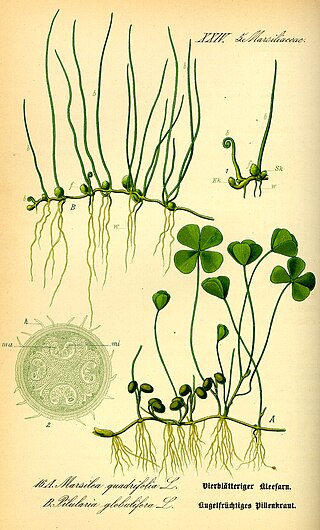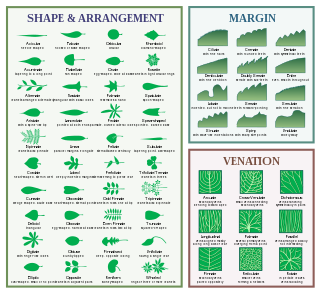
A leaflet in botany is a leaf-like part of a compound leaf. Though it resembles an entire leaf, a leaflet is not borne on a main plant stem or branch, as a leaf is, but rather on a petiole or a branch of the leaf. Compound leaves are common in many plant families and they differ widely in morphology. The two main classes of compound leaf morphology are palmate and pinnate. For example, a hemp plant has palmate compound leaves, whereas some species of Acacia have pinnate leaves.

Marsileaceae is a small family of heterosporous aquatic and semi-aquatic ferns, though at first sight they do not physically resemble other ferns. The group is commonly known as the "pepperwort family" or as the "water-clover family" because the leaves of the genus Marsilea superficially resemble the leaves of a four-leaf clover. In all, the family contains 3 genera and 50 to 80 species with most of those belonging to Marsilea.

The following terms are used to describe leaf morphology in the description and taxonomy of plants. Leaves may be simple or compound. The edge of the leaf may be regular or irregular, may be smooth or bearing hair, bristles or spines. For more terms describing other aspects of leaves besides their overall morphology see the leaf article.

Eucryphia is a small genus of trees and large shrubs native to the south temperate regions of South America and coastal eastern Australia, mainly Tasmania. Sometimes placed in a family of their own, the Eucryphiaceae, more recent classifications place them in the Cunoniaceae. There are seven species, two in South America and five in Australia, and several named hybrids.

Cunoniaceae is a family of 27 genera and about 335 species of woody plants in the order Oxalidales, mostly found in the tropical and wet temperate regions of the Southern Hemisphere. The greatest diversity of genera are in Australia and Tasmania, New Guinea, and New Caledonia. The family is also present in Central America, South America, the Caribbean, Malesia, the islands of the South Pacific, Madagascar and surrounding islands. the family is absent from mainland Asia except from Peninsular Malaysia, and almost absent from mainland Africa apart from two species from Southern Africa. Several of the genera have remarkable disjunct ranges, found on more than one continent, e.g. Cunonia, EucryphiaWeinmannia.

Ceratopetalum is a genus of nine species of shrub and tree in the family Cunoniaceae. They are found along the eastern coast of Australia and extend north to New Guinea. Two Australian species are among the best known, one being C. apetalum or coachwood, renowned as a timber tree, and C. gummiferum, the New South Wales Christmas bush.

Connaraceae is a pan-tropical plant family of 19 genera and more than 180 species of largely evergreen trees, woody shrubs and climbers.
Banksia strahanensis is an extinct species of tree or shrub in the plant genus Banksia. It is known only from a fossil leaf and several fossil leaf fragments found in Early to Middle Pleistocene sediment at Regatta Point in western Tasmania. These are long and very narrow, with entire margins, superficially resembling leaves of the extant B. spinulosa.
Banksieaephyllum is a plant genus that encompasses organically preserved fossil leaves that can be attributed to the Proteaceae tribe Banksieae, but cannot be attributed to a genus.
Banksieaeidites is a plant genus that encompasses fossil pollen that can be attributed to the Proteaceae tribe Banksieae, but cannot be attributed to a genus.

Eucryphia lucida, the leatherwood, is a species of tree or large shrub endemic to forests of western Tasmania, Australia. An attractive plant used in both horticulture and apiculture, it was promoted by the Tasmanian Branch of the then SGAP as an alternative to the Tasmanian blue gum for Tasmania's floral emblem. It was described as E. billiarderi at one stage, this now being a synonym.

The Cerrejón Formation is a geologic formation in Colombia dating back to the Middle-Late Paleocene. It is found in the El Cerrejón sub-basin of the Cesar-Ranchería Basin of La Guajira and Cesar. The formation consists of bituminous coal fields that are an important economic resource. Coal from the Cerrejón Formation is mined extensively from the Cerrejón open-pit coal mine, one of the largest in the world. The formation also bears fossils that are the earliest record of Neotropical rainforests.
Petrocardium is an extinct genus of monocot plants in the family Araceae. At present it contains only two species Petrocardium cerrejonense and Petrocardium wayuuorum, the type species. The genus is solely known from the Middle to Late Paleocene, Cerrejón Formation deposits in Colombia.
Montrichardia aquatica is an extinct species of monocot plant in the family Araceae. M. aquatica is related to the living species M. arborescens and M. linifera. The species is solely known from the Middle to Late Paleocene, fossil-rich Cerrejón Formation in La Guajira, northern Colombia.
Acer alaskense is an extinct maple species in the family Sapindaceae described from a fossil leaf. The species is solely known from the Latest Paleocene sediments exposed in the Matanuska River Valley, Matanuska-Susitna Borough, Alaska. It is the type species for the extinct section Alaskana.

Codia is a genus of trees and shrubs in the family Cunoniaceae. The genus is endemic to New Caledonia in the Pacific and contains 15 species. The leaves are opposite or whorled, simple, and the margin usually entire. The flowers are arranged in capitula. the ovary is inferior. The fruit is indehiscent and is covered with woolly hairs.

The Manuherikia Group is a fluvial-lacustrine sedimentary fill in the Central Otago area of New Zealand, at the site of the prehistoric Lake Manuherikia. The area consists of a valley and ridge topography, with a series of schist-greywacke mountains at roughly ninety degrees to each other. The Manuherika Group occurs in the current basins, and occasionally on the mountains themselves.
Acer eonegundo is an extinct maple species in the family Sapindaceae described from a single partial fossil leaf. The species is known from Eocene sediments exposed in the US state of Nevada. It is placed into the living Acer section Negundo.

Orites diversifolia (=diversifolius), commonly known as variable orites, is a member of the family Proteaceae and is endemic to Tasmania. The common name stems from the variable form of the leaves, which range from entire and linear to serrated and ovate. It is a common shrub in lowland rainforest, subalpine woodland and scrub.

The Salamanca Formation is a geologic formation in the Golfo San Jorge Basin of central Patagonia that yields well-preserved, well-dated fossils from the early Paleocene. Studies of these fossils are providing new data on plant and animal diversity following the end-Cretaceous extinction event.












